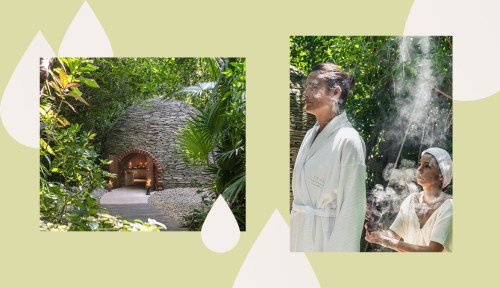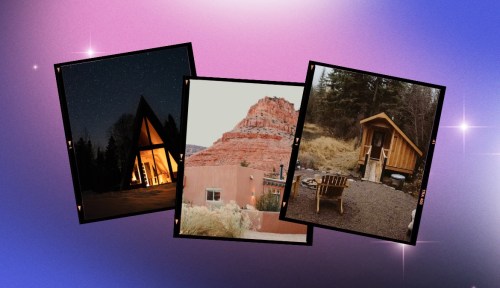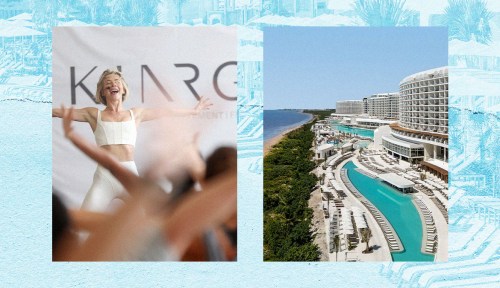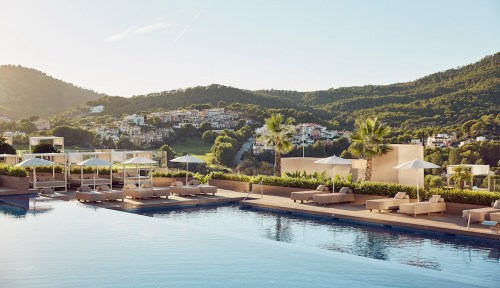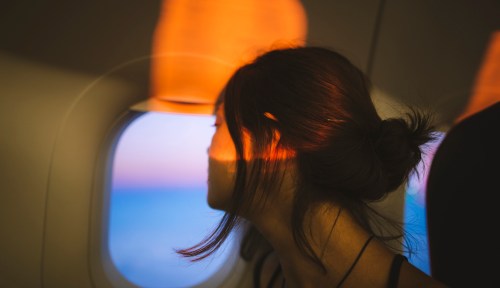Our editors independently select these products. Making a purchase through our links may earn Well+Good a commission
I’m following a winding path around the side of an open-air cenote when a dome made of silvery stone with a small wooden door no higher than my waist comes into view, as does a man shoveling lava rocks in and out of an open-flame furnace. I’m about to begin a Temazcal ceremony at the Rosewood Mayakoba Sense spa in the Riviera Maya region of Mexico, during which a shaman will lead my husband and me through an hour-long session of sweating, chanting, stillness, animal noises, yelling, reflection, and honoring hot rocks called “abuelitas” (little grandmothers).
Experts in This Article
The Temazcal is a ritual sweat lodge historically used by indigenous people in mesoamerica. It was meant to facilitate moments of change; connect with underworld, water, and fertility spirits; cleanse after sickness; recuperate after battle; and socialize, Casey Walsh, author of Virtuous Water: Mineral Springs, Bathing, and Infrastructure in Mexico, tells Atlas Obscura. Today, it’s become a popular wellness attraction in Mexico, which means it’s lately become subject to many of the same claims spas make about saunas around the world: That they are purifying and detoxifying for the body and mind.
My experience in the Temazcal, and hungry appreciation for dry saunas, steam rooms, hot yoga, and the transcendental sweat lodges I did at summer camp as a teen got me wondering: What was up with my—or rather, society’s—love of sweat?
Why we sweat (and why it feels so good)
While sweating at inopportune moments can be the worst, it feels really good to sweat on purpose—and that’s not a biological accident. Sarah Everts, a science journalist and the author of The Joy of Sweat, has delved deep into the mechanisms, purpose, effects, and cultural significance of sweating. She explains that sweating is the way our bodies cool us down. When our body temperature rises, our blood becomes hot, so sweating moves the watery parts of blood out onto the surface of the skin via our sweat glands, which then evaporates when it touches the air, thus cooling us from the outside in.
“Evaporative cooling is humanity’s evolutionary superpower,” Everts says. “It’s a physical process that effectively whisks the heat from our body up and away, and it helps keep our body temperature stable. We need that because we have to exist in a very tight window [of] body temperature, otherwise we die of heat exposure.”
Becoming hot, and subsequently sweating in high volumes, causes your heart to race in order to pump more blood throughout your body. That extra blood flow is one reason why heat can feel so good on your muscles. But the cardiovascular overdrive also prompts the brain to release “happy hormones” like endorphins and adrenaline. Scientists aren’t exactly sure why, but some posit that it’s because a heart workout is good for you from an evolutionary standpoint: A healthier heart equals a better ability to run from predators.
“As a result of that cardiovascular workout where your heart is beating fast in order to move the blood that’s really hot in your core to the exterior of your skin, you’re getting cardiovascular benefits,” Everts says. “Our evolutionary biology is such that we luck out, we get happy hormones, when that happens.”
Bottom line: that feeling of gooey euphoria you get in a sauna? That’s very real, on the level of your brain chemistry’s reaction to your body dealing with the heat. Given this biological advantage, it’s no surprise that versions of saunas (originally a Finnish word) exist around the world, in places as disparate as Mexico, Korea, Russia, and beyond.
“There is this social catharsis that we get from sweating,” Everts says. “That’s a really universal human thing.”
What saunas and sweat lodges do not do is “detox” or “purify” your body, at least physiologically. That’s what your kidney is for. If you have a “toxin” in your blood, like the remnants of last night’s margarita, a negligible amount of it might come out when you sweat. But so do all the beneficial things in the watery parts of your blood, like electrolytes, and incidental stuff, like hormones. Everts points out that if you were going to trulypurify your body through sweat, you would die, because it means that you’d be draining your body of all of its liquid, and dehydrating your blood. Instead, your kidneys and livers filter out the bad stuff, and your body gets rid of it when you go to the bathroom.
“It’s easy for a lot of people to conflate the emotional euphoria, which is definitely a real thing that you experience in a sauna or another hot place, with actual detoxing,” Everts says. “It’s really not a chemical detox.”
That doesn’t mean a hot yoga class, a sit in the schvitz, or, yes, a ceremony in a Temazcal, doesn’t have its benefits. That heart workout is no joke—one 20-year study of Finnish men found that taking multiple saunas per week was associated with longevity and heart health. There’s the muscle relaxation, and the stress-reducing, happiness-boosting brain chemical effect. And on a community level, there’s the experience of going through an ecstasy-inducing ritual with a group all together that fosters closeness and community.
Which takes us back to the Temazcal tucked away by the cenote.
My experience in the Temazcal
The first morning of my trip, I woke up in the Rosewood Mayakoba wellness suite—which came complete with a reflexology pool, essential oils linked to the phases of the moon, aromatherapy pods in the shower, and a beautiful view of the lagoon—and walked down to the Temazcal to meet the resort’s resident shaman. Rosewood Mayakoba director of wellness Emmanuel Arroyo says the shaman comes from a family of shamans, which is one of the ways that Arroyo says Rosewood Mayakoba distinguishes its Temazcal experience from others. The resort also constructed the Temazacal using the orientation of the cardinal directions, which was how the Mayans constructed their famed pyramids and other important structures. Lastly, the domed shape is meant to evoke the feeling of being inside a womb, to stress the Rosewood Mayakoba’s Temazcal experience as one focused on “rebirth.”
“Guests tell me that it’s a place that, just by walking in, inspires them to want to breathe again,” Arroyo says.
So many aspects of the Temazcal were new to me, and to my relationship. As we crawled on our hands and knees into the domed space, we were told to say “For me and for all of my relationships,” which surprised me since I’d previously thought of sweat lodge experiences as about personal discovery.
The ceremony focused on four stages of life: Being a baby and young child, being an adolescent and young adult, growing into maturity, and accepting death. We were supposed to think about and embody those phases, and the people who were part of those phases, while enduring the heat, feeling the herb-scented steam rise, and even listening to instruments that resembled the sounds of jungle animals.
“Mayans associate fire as a process that transforms things,” Arroyo says. “It is a place where you enter with the idea of going through this process of transformation and evolution.”
Getting to tap into my inner child, and envision my future with my husband sitting next to me, deepened the experience in that I knew I wasn’t going through it alone. My husband told me before we entered the Temazcal that he was nervous, because he doesn’t handle heat well. But the heat, the chanting, the doing something wildly out of our comfort zone, and mutually approaching a new experience with respect and openness, made us feel like we had been through something together—which the power of intentional sweating in a ritualized setting facilitated.
“You get social cohesion when, as a group, you experience a challenge and you overcome it,” Everts says. “There is this not just euphoria, but you [also] feel closer to the people around you. There’s something about that that leads to sweating being partly a universal hobby.”
Whether my Temazcal experience at all resembled the practices of indigenous mesoamericans, or whether it was a tourist attraction made palatable for western consumption, I can’t say; Everts notes that indigenous sweat lodge rituals are often so sacred that they are not widely spoken about. Aiming for authenticity in a resort setting is its own form of appropriation, since it suggests that a sacred ritual can and should be replicated for the benefit of white tourists. But my Temazacal ceremony was its own experience—and I feel grateful that I got to partake in the ritual as it was.
At the end of the hour, we were told to exit and say “I am reborn.” Dripping with both the condensation built up by steam in the dome and my own sweat, I knew that I was not physically “purifying” myself. However, the refrain we repeated many times—for me and for my relationships—echoed in the dome, and continues to reverberate when my blood pumps, and my temperature rises, today.
Sign Up for Our Daily Newsletter
Get all the latest in wellness, trends, food, fitness, beauty, and more delivered right to your inbox.
Got it, you've been added to our email list.
